Sunrun Bundle
How Did Sunrun Revolutionize Solar Energy?
Sunrun has reshaped the energy landscape, becoming a leader in residential solar and energy services. Founded in 2007, the company's innovative approach has made solar power accessible to a wider audience. Its journey from a startup to a major player in the Sunrun SWOT Analysis showcases its significant impact on the industry.
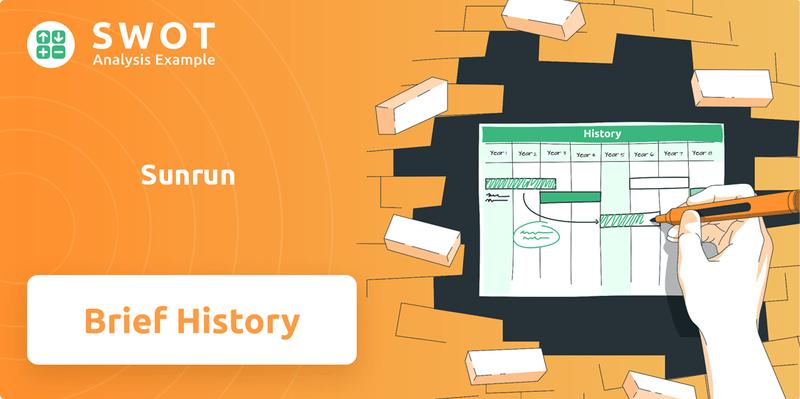
Sunrun's early focus on solar-as-a-service, like power purchase agreements, was a game-changer for the adoption of solar panel installation. This model removed the high upfront costs, allowing more homeowners to embrace solar energy. Understanding the brief history of Sunrun, including its founding date and key milestones, is crucial to grasping its current market position and future potential in the residential solar sector.
What is the Sunrun Founding Story?
The Sunrun history began on September 27, 2007. The company was founded by Lynn Jurich, Ed Fenster, and Adam Buttles. Their combined expertise in finance, technology, and solar installations formed the foundation for a new approach to residential solar energy.
The founders identified a significant barrier to entry in the solar market: the high upfront cost of solar panel systems. Their solution was to offer solar-as-a-service, using solar leases and power purchase agreements (PPAs). This allowed homeowners to access solar power without the burden of ownership, paying a fixed monthly fee for the electricity generated.
This innovative business model, which aimed to make solar energy more accessible, helped shape the early years of the
Sunrun was founded in 2007 to make solar energy more accessible. The company's initial focus was on residential solar solutions.
- Lynn Jurich and Ed Fenster, both Stanford Graduate School of Business alumni, brought financial and technological expertise.
- Adam Buttles contributed crucial operational knowledge in solar installations.
- The core problem they addressed was the high upfront cost of solar panel systems.
- Their business model centered on solar leases and power purchase agreements (PPAs).
Sunrun SWOT Analysis
- Complete SWOT Breakdown
- Fully Customizable
- Editable in Excel & Word
- Professional Formatting
- Investor-Ready Format
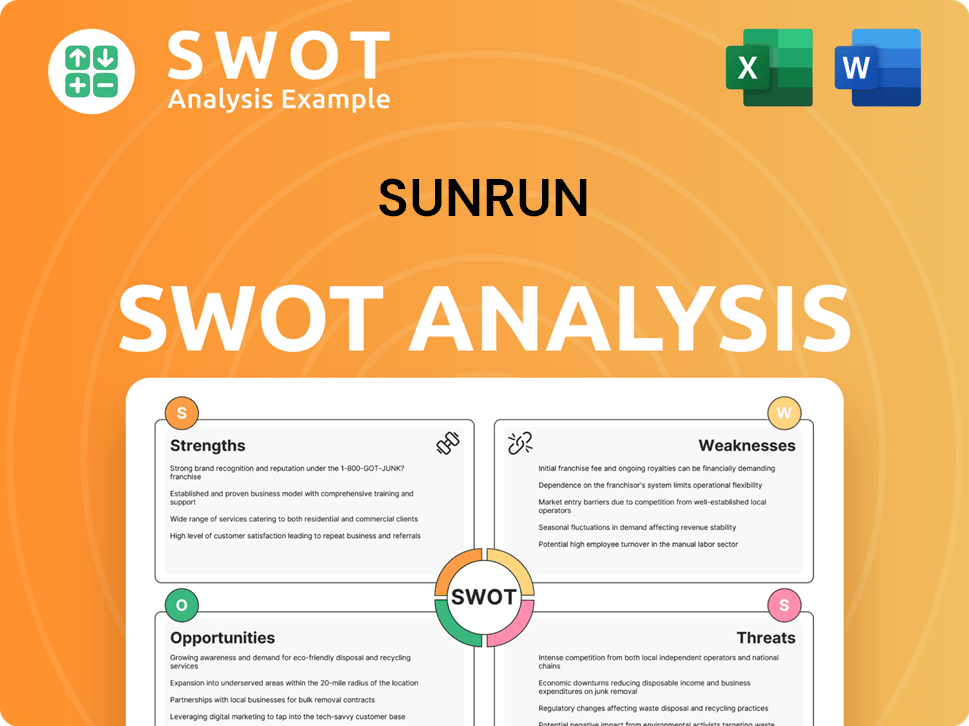
What Drove the Early Growth of Sunrun?
The early growth of the Sunrun company was marked by a swift expansion of its solar-as-a-service model across various states. Following its establishment in 2007, the company quickly gained a foothold in key solar markets, including California, Arizona, and Massachusetts. By 2010, Sunrun had deployed over 10,000 solar systems. This initial phase focused on refining its Power Purchase Agreement (PPA) and lease agreements to attract homeowners.
Sunrun's expansion involved entering key solar markets. The company focused on refining its PPA and lease agreements during this time. Early customer acquisition strategies included direct sales and partnerships.
Securing project financing from institutional investors was crucial for funding installations. In 2013, Sunrun raised $150 million in venture capital. This funding supported the company's rapid expansion and service offerings.
The company expanded its service offerings beyond just solar panel installation. By 2014, Sunrun had expanded its operations to 13 states. The competitive landscape included other solar companies.
Sunrun's focus on its PPA model helped differentiate it from competitors. The company's ability to secure large-scale financing was also a key differentiator. This period saw the initial team expansion and the establishment of regional offices.
Sunrun PESTLE Analysis
- Covers All 6 PESTLE Categories
- No Research Needed – Save Hours of Work
- Built by Experts, Trusted by Consultants
- Instant Download, Ready to Use
- 100% Editable, Fully Customizable
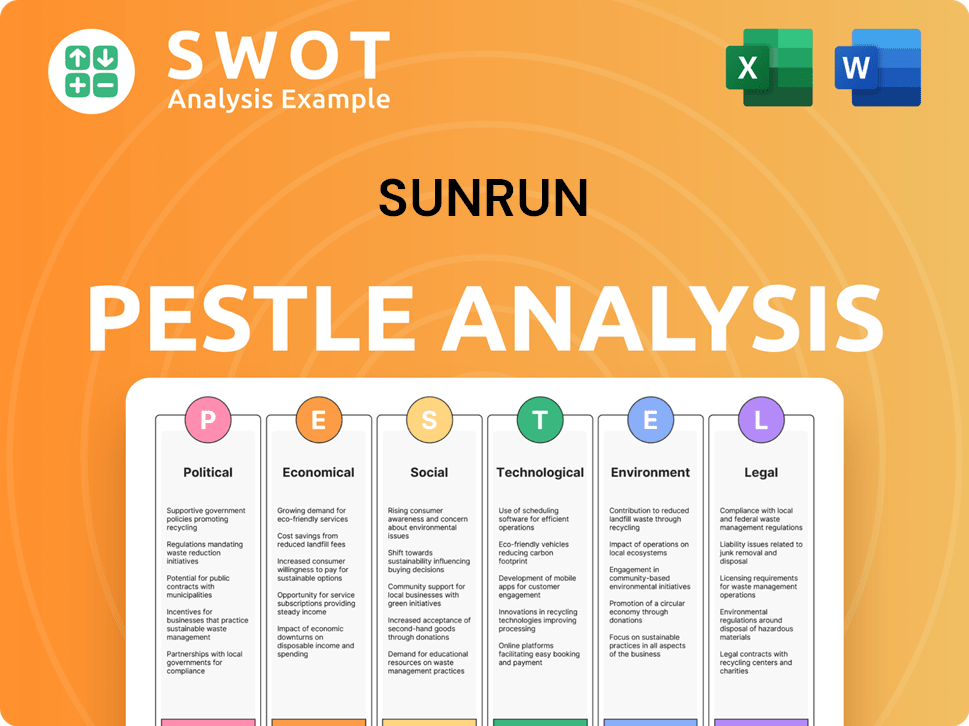
What are the key Milestones in Sunrun history?
The Sunrun company has achieved numerous milestones since its founding, significantly impacting the solar energy industry. Its journey includes pivotal moments in residential solar panel installation and expansion, making it a key player in the renewable energy sector.
| Year | Milestone |
|---|---|
| 2007 | Founded with a mission to accelerate the world's transition to sustainable energy. |
| 2015 | Went public on the Nasdaq stock exchange under the ticker RUN, securing capital for further growth. |
| 2020 | Acquired Vivint Solar, consolidating its position as a leading residential solar provider in the U.S. |
| 2023 | Installed over 4.5 gigawatts of solar capacity and over 500 megawatt-hours of battery storage. |
Sunrun pioneered the solar-as-a-service model, making residential solar accessible without large upfront investments. The company further innovated by integrating battery storage solutions, enhancing energy independence for homeowners. Check out the Marketing Strategy of Sunrun for more insights.
This model allowed homeowners to access solar power without the high initial costs, promoting wider adoption of solar energy.
Sunrun integrated battery solutions, enabling homeowners to store excess solar energy and improve energy resilience, especially during power outages.
Sunrun has faced challenges such as intense competition and regulatory changes. Market fluctuations and shifts in government incentives have also impacted the company, requiring strategic adaptations.
The solar energy market is highly competitive, requiring continuous innovation and customer focus.
Navigating varying net metering policies across different states directly impacts the economics of residential solar, necessitating strategic adjustments.
Sunrun Business Model Canvas
- Complete 9-Block Business Model Canvas
- Effortlessly Communicate Your Business Strategy
- Investor-Ready BMC Format
- 100% Editable and Customizable
- Clear and Structured Layout
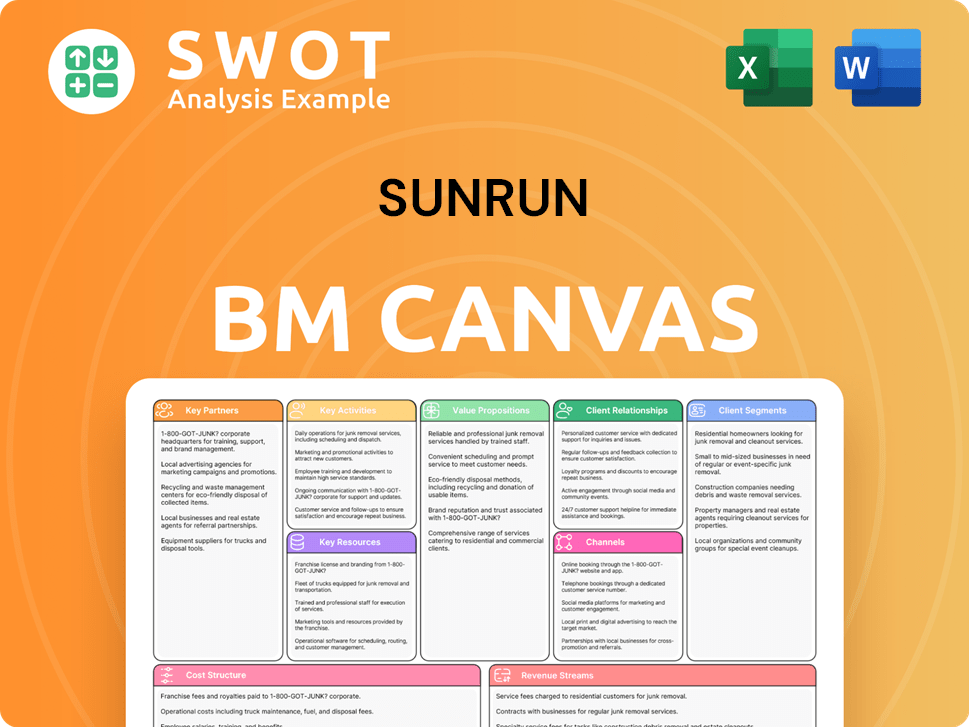
What is the Timeline of Key Events for Sunrun?
The Sunrun company journey is marked by significant milestones, reflecting its growth and impact in the residential solar market. Founded in 2007, the company quickly established itself as a leader in the solar-as-a-service model. Early successes, including deploying over 10,000 solar systems by 2010, paved the way for further expansion. Key events such as the 2015 IPO and the 2020 acquisition of Vivint Solar, significantly boosted its market position. Sunrun's customer base has grown substantially, reaching over 900,000 customers by 2023, demonstrating its increasing influence in the solar energy sector.
| Year | Key Event |
|---|---|
| 2007 | Founded in San Francisco, California, by Lynn Jurich, Ed Fenster, and Adam Buttles. |
| 2008 | Introduces its solar-as-a-service model, offering solar leases and power purchase agreements. |
| 2010 | Deploys over 10,000 solar systems, demonstrating early market acceptance. |
| 2013 | Secures $150 million in venture capital funding to accelerate growth. |
| 2015 | Goes public on the Nasdaq stock exchange (NASDAQ: RUN). |
| 2016 | Expands its offerings to include battery storage solutions for homeowners. |
| 2020 | Completes the acquisition of Vivint Solar, solidifying its position as the largest U.S. residential solar company. |
| 2022 | Surpasses 700,000 customers nationwide. |
| 2023 | Reaches over 900,000 customers across 20 states. |
| 2024 | Continues to expand its virtual power plant initiatives and energy management solutions. |
Sunrun is actively developing VPPs, aggregating residential solar and battery systems to provide grid services. This initiative enhances grid stability and reduces reliance on traditional power plants. VPPs are a significant component of Sunrun's strategy to integrate distributed energy resources and support the transition to a more sustainable energy grid. The company is focused on expanding its VPP capabilities to meet growing demand.
Sunrun is focused on further integrating battery storage and energy management solutions. These solutions create a more resilient and decentralized energy grid. The company is expanding its offerings to provide homeowners with comprehensive energy management tools. This approach aligns with the increasing consumer demand for home energy independence and grid resilience.
Analysts predict continued growth in the residential solar market, driven by increasing consumer demand for clean energy. Declining technology costs and favorable government incentives are also supporting growth. Sunrun is well-positioned to capitalize on this expansion by continually expanding its market share and service offerings. The company is committed to reaching millions of homes.
Sunrun has a strong focus on expanding its customer base. The company aims to reach millions of homes, emphasizing home energy independence and the transition to a sustainable energy future. The company's strategy includes expanding its geographic footprint and enhancing its service offerings. Sunrun's commitment to customer growth is central to its long-term vision.
Sunrun Porter's Five Forces Analysis
- Covers All 5 Competitive Forces in Detail
- Structured for Consultants, Students, and Founders
- 100% Editable in Microsoft Word & Excel
- Instant Digital Download – Use Immediately
- Compatible with Mac & PC – Fully Unlocked
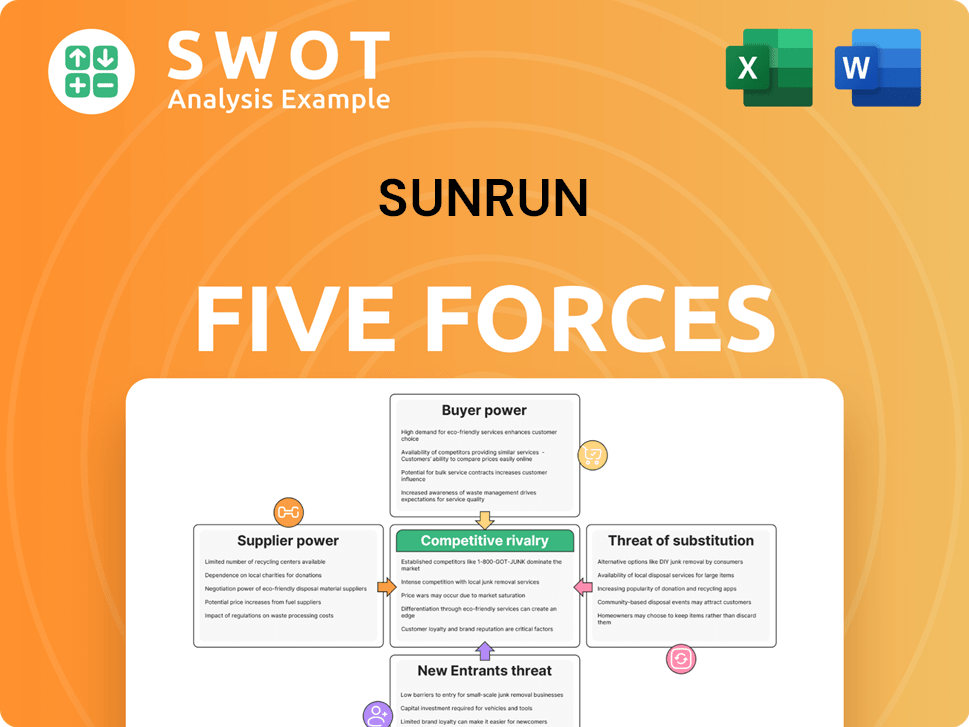
Related Blogs
- What is Competitive Landscape of Sunrun Company?
- What is Growth Strategy and Future Prospects of Sunrun Company?
- How Does Sunrun Company Work?
- What is Sales and Marketing Strategy of Sunrun Company?
- What is Brief History of Sunrun Company?
- Who Owns Sunrun Company?
- What is Customer Demographics and Target Market of Sunrun Company?
Disclaimer
All information, articles, and product details provided on this website are for general informational and educational purposes only. We do not claim any ownership over, nor do we intend to infringe upon, any trademarks, copyrights, logos, brand names, or other intellectual property mentioned or depicted on this site. Such intellectual property remains the property of its respective owners, and any references here are made solely for identification or informational purposes, without implying any affiliation, endorsement, or partnership.
We make no representations or warranties, express or implied, regarding the accuracy, completeness, or suitability of any content or products presented. Nothing on this website should be construed as legal, tax, investment, financial, medical, or other professional advice. In addition, no part of this site—including articles or product references—constitutes a solicitation, recommendation, endorsement, advertisement, or offer to buy or sell any securities, franchises, or other financial instruments, particularly in jurisdictions where such activity would be unlawful.
All content is of a general nature and may not address the specific circumstances of any individual or entity. It is not a substitute for professional advice or services. Any actions you take based on the information provided here are strictly at your own risk. You accept full responsibility for any decisions or outcomes arising from your use of this website and agree to release us from any liability in connection with your use of, or reliance upon, the content or products found herein.